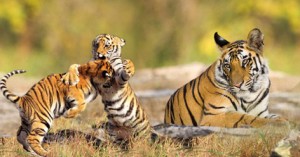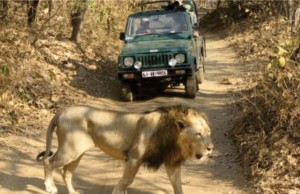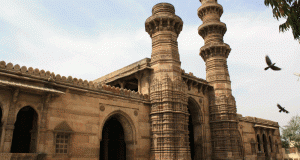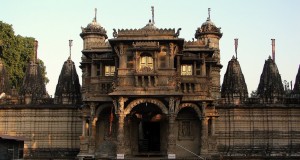 capable of climbing up a tree with a full-grown stag in its mouth) and animals like bear, langur, barking deer, chousingha (four-horned antelope), fox, hyena and blackbuck. There is a large population of nilgai or blue bull, a species of antelope which, like the peacock, has enjoyed a considerable degree of natural protection by virtue of its religious associations: it resembles the sacred cow. The forest is also known for its many reptiles, including cobra, python, viper and marsh crocodile.Had Gir not been designated a lion sanctuary, it surely would have established itself as a major bird sanctuary. There is an incredible variety of bird life here including green pigeon, oriole, partridge, painted sandgrouse, rock bush-quail and paradise fly-catcher. In all, there are over 200 different varieties of birds to be seen, one of the most common being India’s national bird, the peacock.Rugged individualists can take their own vehicles into the sanctuary, provided they hire the obligatory guide to go with them. Alternatively, they can hire a private jeep, with guide, for about Rs400 per trip from the Forest Bungalow. If going in on your own initiative, aim to be in the forest interior either very early in the morning, or during the late afternoon. At these times, you’ll see a lot more. During the heat of the day, most animals have gone ‘deep’ to keep cool.The small village of Sasan-Gir is the main shopping market for the area (locals travel all the way in from the forest interior to buy supplies here) but, apart from a few unremarkable modern temples, is not of special interest. This said, just down the road from the bus-stand, outside the Forest Lodge there is something worth seeing—Gir’s Crocodile Breeding Centre.
capable of climbing up a tree with a full-grown stag in its mouth) and animals like bear, langur, barking deer, chousingha (four-horned antelope), fox, hyena and blackbuck. There is a large population of nilgai or blue bull, a species of antelope which, like the peacock, has enjoyed a considerable degree of natural protection by virtue of its religious associations: it resembles the sacred cow. The forest is also known for its many reptiles, including cobra, python, viper and marsh crocodile.Had Gir not been designated a lion sanctuary, it surely would have established itself as a major bird sanctuary. There is an incredible variety of bird life here including green pigeon, oriole, partridge, painted sandgrouse, rock bush-quail and paradise fly-catcher. In all, there are over 200 different varieties of birds to be seen, one of the most common being India’s national bird, the peacock.Rugged individualists can take their own vehicles into the sanctuary, provided they hire the obligatory guide to go with them. Alternatively, they can hire a private jeep, with guide, for about Rs400 per trip from the Forest Bungalow. If going in on your own initiative, aim to be in the forest interior either very early in the morning, or during the late afternoon. At these times, you’ll see a lot more. During the heat of the day, most animals have gone ‘deep’ to keep cool.The small village of Sasan-Gir is the main shopping market for the area (locals travel all the way in from the forest interior to buy supplies here) but, apart from a few unremarkable modern temples, is not of special interest. This said, just down the road from the bus-stand, outside the Forest Lodge there is something worth seeing—Gir’s Crocodile Breeding Centre.  Here, in a pleasant green compound around 700 sleepy crocs live, ranging in size from 13 cm (5 in) to 1.5 m (5 ft). The staff are very friendly, and will let you handle the little monsters, but watch out for those 66 baby teeth. This centre was established in 1976/7 to counter the sudden decline in numbers of Marsh Crocodile or ‘Mugger’. Eggs are collected from the nearby Kamleshwar Dam, and brought to the breeding centre to be artificially hatched.
Here, in a pleasant green compound around 700 sleepy crocs live, ranging in size from 13 cm (5 in) to 1.5 m (5 ft). The staff are very friendly, and will let you handle the little monsters, but watch out for those 66 baby teeth. This centre was established in 1976/7 to counter the sudden decline in numbers of Marsh Crocodile or ‘Mugger’. Eggs are collected from the nearby Kamleshwar Dam, and brought to the breeding centre to be artificially hatched.
Another worthwhile visit is the Forestry Department’s marvellous Orientation Centre. This is a very fine exhibition, employing maps, photographs and clear, descriptive panels to outline the history, background, and wildlife content of the sanctuary. It is the product of the Nehru Foundation for Development, Ahmedabad. Until recently the park organised a ‘lion show’. This allowed you to see Asiatic lions from very close quarters, as part of an organised jeep-safari party. These have now been discontinued—hopefully, they will start up again soon. However you enter the sanctuary—by jeep, by car or on a park organised tour in one of their jeep-minibuses, you must get permission from the Forest Ranger and pay the necessary entry (Rs25) and camera fees (Rs10). With the help of a good park ranger/driver you can be fairly sure of seeing lion.
Excursions
If you’re not at Sasan-Gir just for the lions, you can hire a jeep and visit some interest spots further inside the forest. Of these, the most beautiful and the most difficult to get to is Tulishyam Hot Springs (96 km; 60 miles), a very scenic spot where you can bathe in natural sulphur springs, visit a very special temple to Bhim and his mother Kunti, and stay at the pleasant Toran Holiday Home (dorm and single/double beds Rs8-40). Much nearer is Sirvan Village (13 km; 8 miles), where siddi people of African origin live, retaining their own distinctive culture and way of life. The 1000 or so villagers have a fine tradition of dance, and can, for a donation, be persuaded to put on special shows for the benefit of visitors. If you want to see a tribal dance show, call in at Jambur Village 25 km (15 1/2 miles) away, on a Thursday, when a weekly festival takes place at the tomb of a respected holy man. Kamleshwar Dam, a beautiful location with an area of over 3 sq km (1 1/4 sq miles), is worth visiting when there’s water in it (October-December, after the monsoons), but is a wasted trip when there isn’t.





